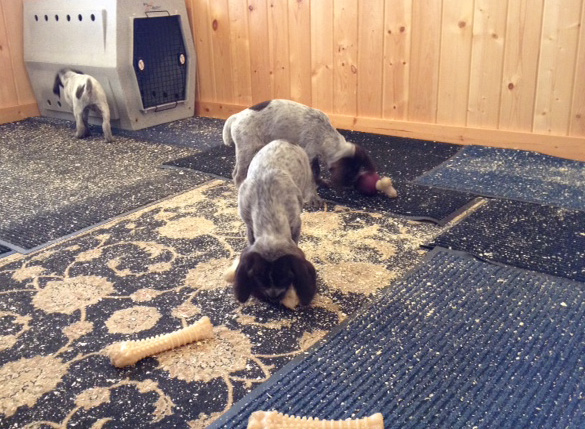Can’t go outside? Improvise! One more new space to play in!
The departure day for the puppies is getting close and we have a couple of recommendations:
We’ve been monitoring the puppy space continually since they were whelped. Right now 70 degrees is the lowest they seem to be managing without shivering, so we recommend a minimum of 72 degrees for the room temperature when you get them home, especially when they’re lying still/not moving around.
We’ll provide a few “pee pads” for you but suggest that you pick up a box of 22″ x 23″ (more or less) pee pads, available at Target or Petco, for the transition to peeing outside. This weather is so cold that you’ll never get your coat on quickly enough when you see your puppy is about to go (body language you will quickly learn). But if there is a pee pad right near the door, you can carry your puppy right to it, set him/her on the pad and teach that the pee pad is a “good” place to go potty (or whatever you call it at your house.) Lots of affirmation and a bit of urine pressed onto the pad (from a previous pad) will increase successful use of the pee pads. DO get into the habit of being ready to take your puppy outside (on leash) as often as possible so that he/she learns that outdoors is the place where peeing and pooping happen. You won’t have to stay out long if you go out when he/she comes out of the crate after napping, after a meal or after a few minutes of playing. The pee pad near the door should be just a transitional place to go.
The puppies have gravitated to the little polar fleece blankets that we’ve set out for them. Actually we bought a couple of bed-sized polar fleece blankets and cut them into 30″ x 30″ pieces). These make the ideal kennel/crate bedding, either a couple of them folded and layered one on top of the other or one polar fleece blankette on an old towel (not a frayed towel, however, as they will just shred it further, and that’s NOT good for digestive systems.)
I’ve been re-reading the little AKC New Puppy Handbook and it has a lot of great information, developmental stage by stage. It includes a reminder that treats should be very small (Biff recommends soft ones to start) and you’ll want to consider them as part of your puppy’s total calorie intake, just like human treats.

